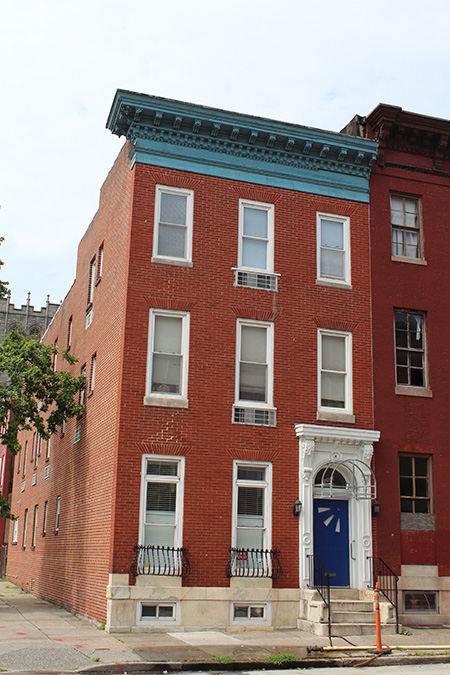Determining whether or not a building is "historic" is a three-step process
that first involves Identification, followed by Evaluation, and finally Designation. Not all old buildings meet the legal
or generally-accepted definitions of "historic", but it is important to note that there are different definitions,
processes, and criteria used to evaluate historic significance.
Identification of Historic Properties
 YWCA, 1200 Druid Ave, Baltimore, located in the Old West Baltimore Historic District. Photographed August 2020 by Nicole Diehlmann.
YWCA, 1200 Druid Ave, Baltimore, located in the Old West Baltimore Historic District. Photographed August 2020 by Nicole Diehlmann.
Generally speaking, the
first step in historic preservation projects, research, and documentation is the identification of potentially historic
properties. For purposes of the National Register of Historic Places,
properties usually must be at least 50 years old or older to be considered for listing. When properties are identified,
researchers, consultants, owners, or community members may record basic information about a property including construction
date, architectural style and notable features, important persons or events associated with the property, and take
photographs to document the property. For archaeological resources, this may involve historical research, examination of
reports about other archaeological resources in the area, and may include some ground disturbance to determine if
resources do exist.
Simply documenting a property does not mean that it is historically significant or designated in any way. This is
simply a research activity to gather basic information and determine what the next steps should be, if any. All data
gathered through survey projects in Maryland is collected in the Maryland
Inventory of Historic Properties (MIHP) and is made available to the public online or by visiting
the MHT Library.
Evaluating Historical Significance
After a potentially historic property has been identified, its significance to local, state, or national history;
architecture; and/or culture is evaluated against objective criteria. The most common set of criteria used for evaluation
is the National Register of Historic Places Criteria for Eligibility.
National Register Criteria
To be eligible for the National Register, a property must demonstrate significance in terms of one or more of four
broad criteria:
- events or trends;
- association with individuals who made a demonstrable and lasting contribution;
- architectural merit;
- or the potential to yield information that will contribute to a better understanding of our past.
 View of the Annapolis National Historic Landmark District.
View of the Annapolis National Historic Landmark District.
Integrity
In addition to demonstrating significance, a property must retain physical integrity to reflect that significance; it
must not have been substantially altered since the period when the event occurred or the person lived there.
- Architecturally significant properties must retain the majority of the features that characterize their type.
- Archaeological sites must remain intact.
Local governments may determine their own criteria for evaluating historic properties, but these generally follow the
National Register of Historic Places criteria. However, please contact your
local Historic
Preservation Commission for more information.
Designation of Properties as "Historic"
There is no one definition of a “historic” building. Instead, there are a variety
of “historic” designations at the federal, state and local levels. The type of regulation depends
on the type of historic designation on the property. These designations do not mean that property owners are
prohibited from making any changes to a property; they ensure that changes made to a property do not harm
important historic features. There are three types of designation of which you should be aware:
- Maryland Inventory of Historic Properties: Listing on the MIHP does not trigger any
regulatory review. The MIHP is solely a research and educational tool.
- National Register of Historic Places: Projects involving properties listed in the
National Register of Historic Places (individually listed or within districts) are reviewed by MHT for
compliance with State and federal laws, generally referred to as
Section 106 Review,
only if state or federal funds, licenses or permits are involved (e.g. highway
funding, Preserve America grants, Federal Energy Regulatory Commission licenses, and Corps of Engineers
permits). If there are no state or federal licenses, permits or funding involved in your project, then there
is no review of National Register-listed properties.
- Local Historic Designation: Local Historic Designation is the most common review
associated with historic properties. In Maryland, county and municipal governments may choose to enact
a historic area zoning ordinance that is consistent with
Article 66B, Section 8.01-8.17.
Under such an ordinance, local elected officials designate
individual historic properties or historic districts and appoint a Historic Preservation Commission (HPC) to
review and approve exterior changes to designated properties. This includes changes to windows, doors,
walls, roofs, porches, yards, sidewalks, storefronts, signs, etc. The HPC review does not include interior
arrangements, zoning, or how a building is used. Generally, work that does not involve a change in
design, materials, or appearance (e.g. painted a previously painted building) is considered "ordinary
maintenance" and is not subject to HPC review.
In some cases, properties may have multiple designations. If a property is listed on the National Register
and designated as a local landmark or within National Register or local historic districts, then both reviews would
be required, if applicable.